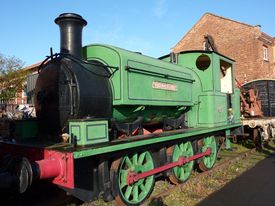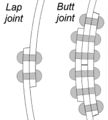2047 Warwickshire
Contents
2047 in service
2047 was delivered to Rugby Portland Cement Co Ltd (RPC) at their New Bilton Works near Rugby on 9 August 1926. It remained there throughout its working life apart from a brief move to RPC’s nearby Southam Cement Works during 1943.
In 1954 2047 received a new inner firebox and other major firebox repairs. The locomotive was finally withdrawn from use in December 1966.[2]
2047 in preservation
Following withdrawal, RPC offered the locomotive to the Warwickshire Railway Society. A separate group, the Warwickshire Industrial Loco Preservation Group was formed and the necessary funds raised by a share issue (£150 for the locomotive and £150 for transport and spares). After an inspection was carried out in July 1967, 2047 was purchased and arrived on the Severn Valley Railway on 22 October 1967.[3]
First boiler ticket
The locomotive was first steamed in December 1968 and initially finished in an unlined pale blue livery. Black and white lining and "Warwickshire" name plates were later applied in time for a planned naming ceremony in 1970, although this had to be re-arranged and was eventually carried out on 3 April 1971 by Mr H A Vigar, the former manager of RPC’s New Bilton Works.[4]
In August 1974, 2047 attended the Town and Country Fair at Stoneleigh. For the occasion the locomotive was repainted in a ‘Caledonian Railway’ lined blue livery and, with the consent of the Lord Lieutenant of Warwickshire, the Warwickshire Crest (the ragged bear and staff) was hand painted on the cab sides. The locomotive was confined to a short demonstration track only 40 feet in length, but managed to accumulate 8½ miles in the course of giving 2,500 footplate rides.[5]
Second boiler ticket and boiler failure
In 1975 2047 was withdrawn for the boiler to be retubed. It returned to service in 1977, being mainly used on works trains at Arley. In December of that year a leaking fusible plug was discovered and the locomotive was again withdrawn. Although this would normally be expected to be a simple fix, a series of delays followed, mainly due to the lack of available boilersmith resources and the relative low priority of a locomotive not used on passenger services. By 1983 only a brief examination had been carried out which determined that the failed plug was not a BR standard size. A more detailed inspection in 1984 determined that the inner firebox fitted in 1954 had become very thin and would require considerable work; also the smokebox, smokebox door and ashpan would need to be replaced and the boiler retubed again.[6]
By 1988 the work had still not been carried out, and work on other boilers was being delayed while the new Bridgnorth boiler shop was built. The WILPG therefore sent the boiler from 2047 Warwickshire to Pridhams for overhaul. By August 1989, a report had been received confirming that the thickness of the boiler plate was below the acceptable level for further use and that repairs would not be economical. In addition, the use of the lap joints (see below) would potentially make the boiler uninsurable even if it was repaired.
In June 1992 it was agreed to return the boiler so that 2047 could be cosmetically restored and placed on static display at Kidderminster Railway Museum. In November 1993, the WILPG formed the Warwickshire Industrial Locomotive Trust to raise funds for building a new boiler. The cosmetic overhaul was completed in June 1995, included repainting into the original RPC green livery. After a period on display at Hampton Loade, 2047 was put on display outside Kidderminster Railway Museum on 15 February 1997.
Mileage recorded during the first and second boiler tickets as report in SVR News was as follows:
| Year | Mileage |
|---|---|
| 1971 | 196 |
| 1972 | 182 |
| 1973 | 76 |
| 1974 | 82 |
| 1975 | 20 |
| 1976 | 0 |
| 1977 | 260 |
| Total | 816 |
Note: The locomotive was first steamed in 1968 as recorded in David Cooke's photograph above. However none of the cumulative mileage tables in SVR News show any mileage before 1971.
Current status
The long awaited overhaul of 2047 began in with a move to Bridgnorth in November 2010. As of 2017[update] the overhaul is in progress at the Bridgnorth Loco Works, although a number of components have been moved to Bewdley for work to be done there. Pictures of progress at both locations can be seen on the Warwickshire Industrial Locomotive Preservation Trust web site 2047 restoration page.
Boiler lap joints
The simplified diagram shows the cross section of boilers constructed using a lap joint (left) and butt joint (right). In the former, the metal sheet forming the boiler barrel is rolled beyond a circle and the overlapping edges are secured with two rows of rivets. In the latter, the two edges of the boiler barrel are butted together and outer and inner plates are used to reinforce the join. In the 1989 report, the practice of using lap joints was described as having been "proved many years ago to be defective and dangerous and whilst not prohibited in existing boilers, was made subject to very stringent and highly expensive testing procedures".[7]
The first photograph shows 2047’s old boiler at Bridgnorth in 2016. The ‘haycock’ firebox, so called because of the unusual height, is on the left with the boiler barrel on the right. The lap joint in the latter is secured by the two rows of rivets to the right. The other photographs show part of a boiler barrel (stood on end) constructed using a butt joint, with the smaller outer plate secured by four rows of rivets and the larger inner plate by a further two rows of rivets.
See also
Steam Locomotives
Warwickshire Industrial Loco Preservation Group
SVR-based locomotives visiting other events
Rolling stock currently under restoration
References
- ↑ Shaw (1998) p. 45.
- ↑ Shaw (1998) p. 49.
- ↑ Shaw (1998) p. 51.
- ↑ Shaw (1998) p. 52-53.
- ↑ Shaw (1998) p. 54.
- ↑ Shaw (1998) p. 55.
- ↑ JA Rees, SVR Chief Engineer, cited in Shaw (1998) p. 56-57.
| ||||||||||||||||||||||||||||||||||||||||||||||||||||||||






